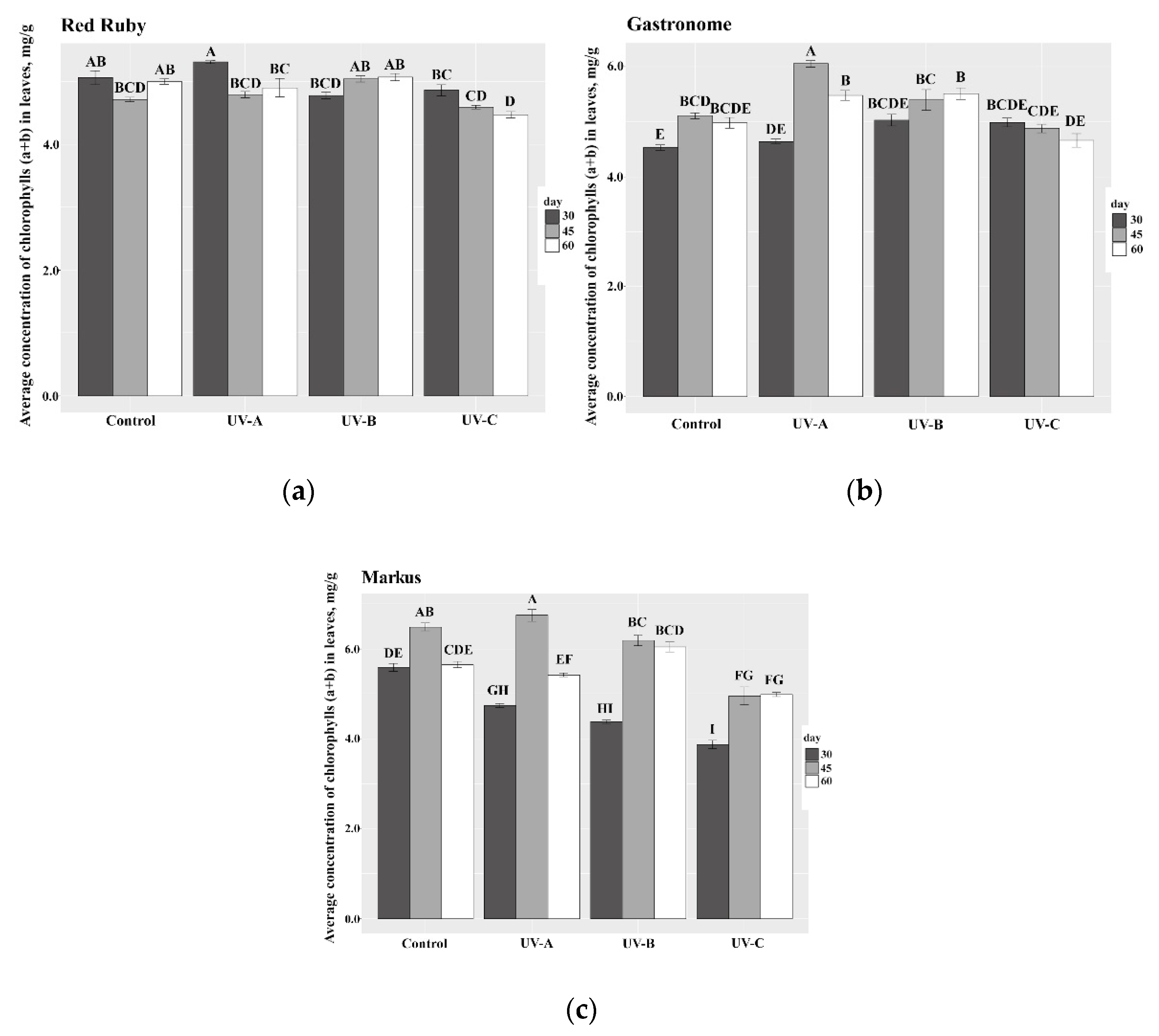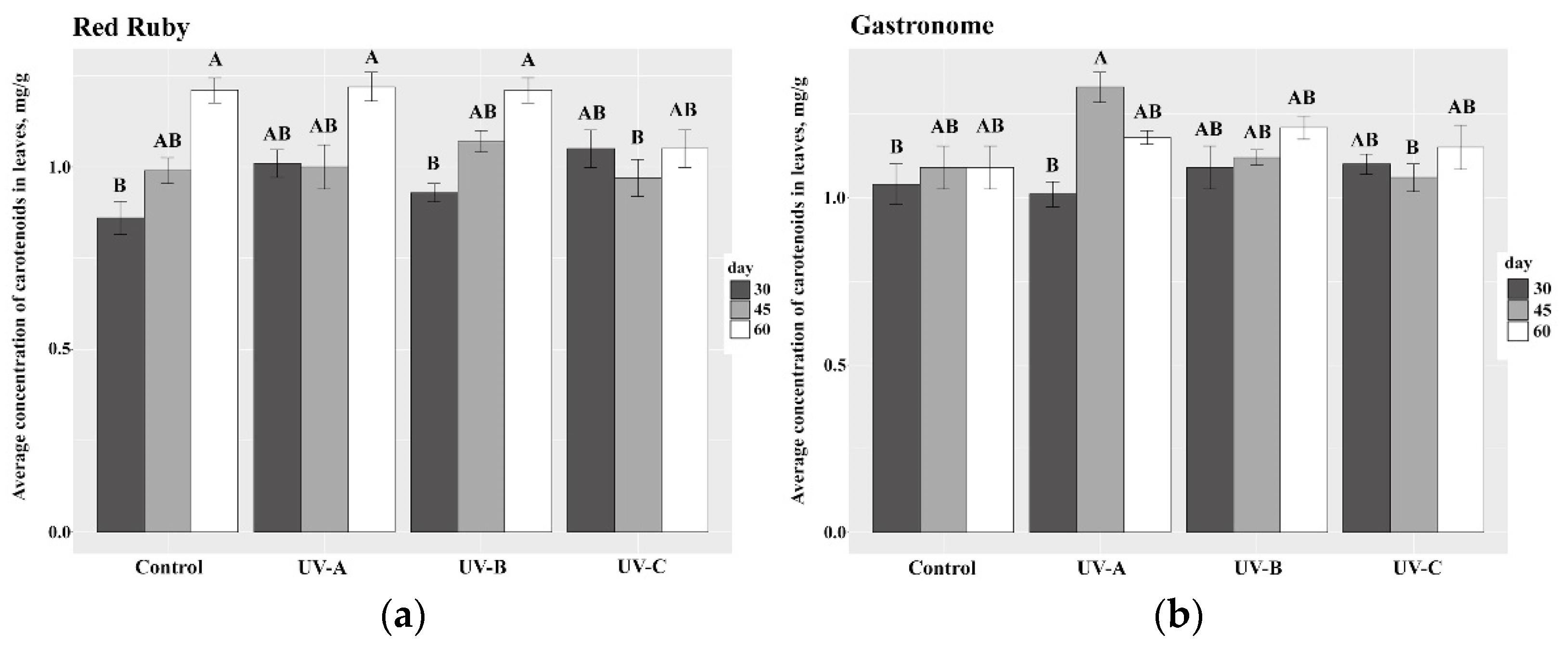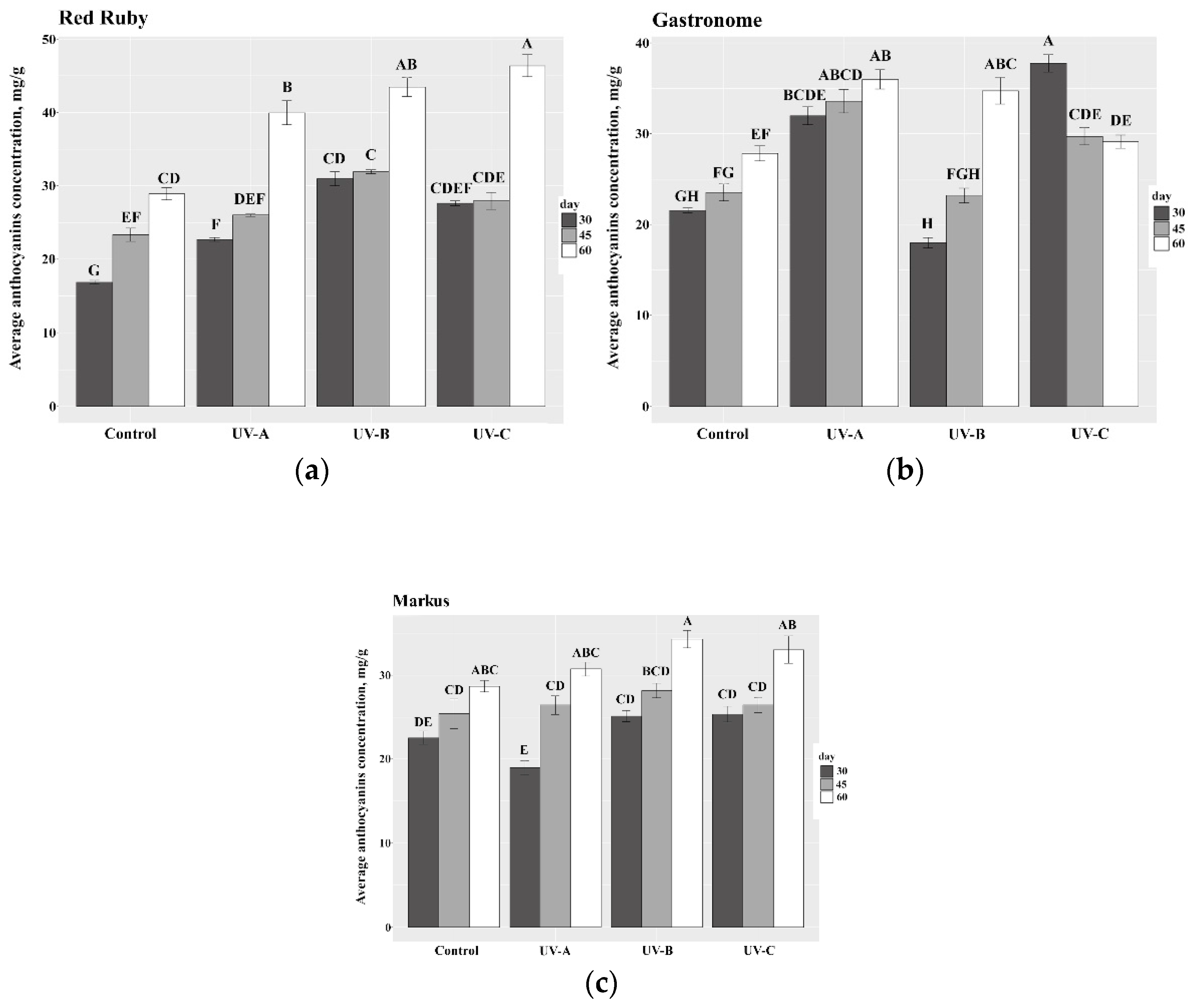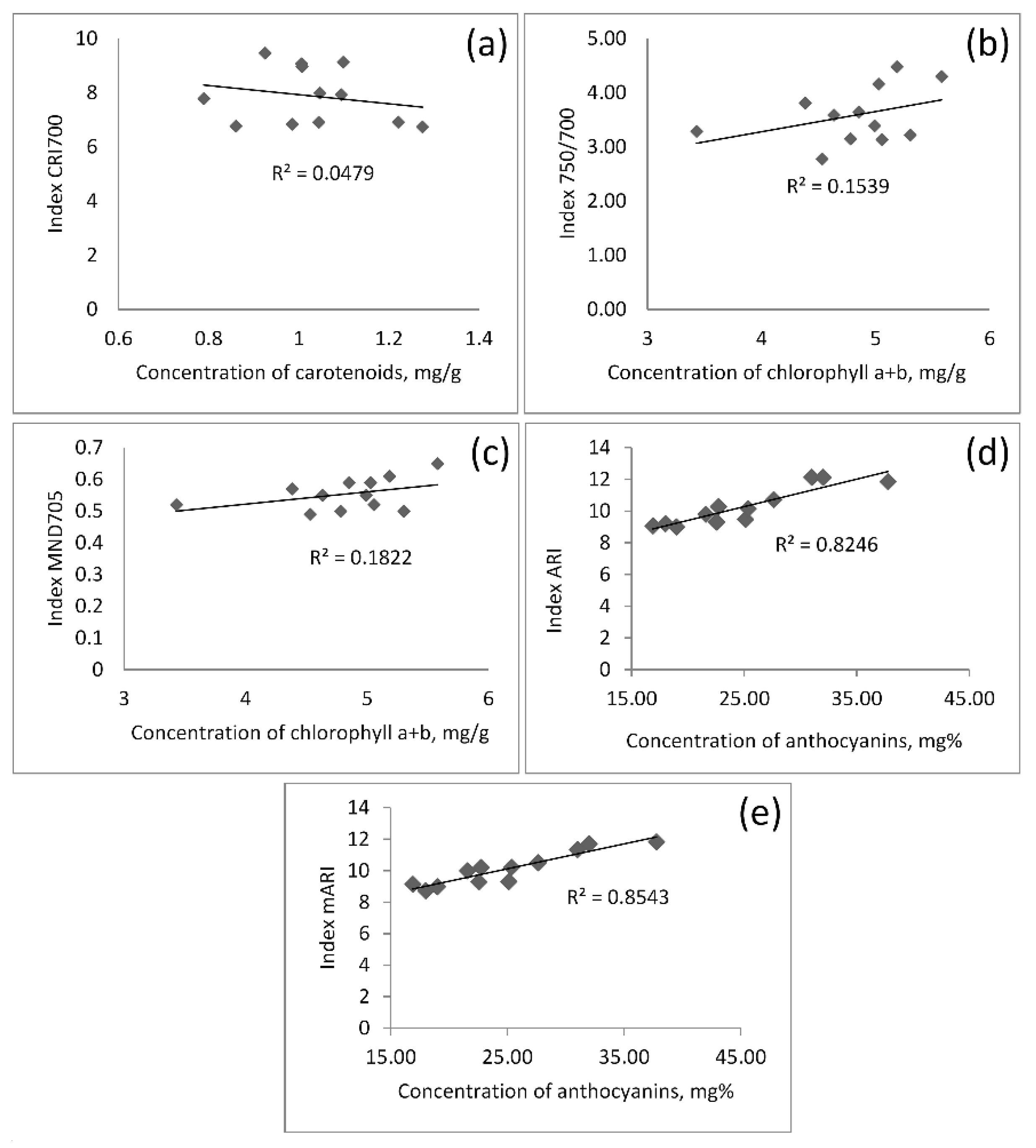Assessment of Ultraviolet Impact on Main Pigment Content in Purple Basil (Ocimum basilicum L.) by the Spectrometric Method and Hyperspectral Images Analysis
Abstract
1. Introduction
2. Materials and Methods
2.1. Vegetable Material
2.2. Cultivation Conditions
2.3. Irradiation Conditions
2.4. Analysis of Pigment Content
2.5. Vegetative Indices Calculation
2.6. Statistical Analysis
3. Results and Discussion
3.1. Analysis of Basil Plants Habitus
3.2. Analysis of Pigment Content
3.3. Analysis of Vegetative Indices
4. Conclusions
Author Contributions
Funding
Institutional Review Board Statement
Informed Consent Statement
Data Availability Statement
Conflicts of Interest
References
- Ganzeveld, L.; Bouwman, L.; Stehfest, E.; van Vuuren, D.P.; Eickhout, B.; Lelieveld, J. Impact of future land use and land cover changes on atmospheric chemistry-climate interactions. J. Geophys. Res. Atmos. 2010, 115, D23301. [Google Scholar] [CrossRef]
- Parrish, D.D.; Derwent, R.G.; Staehelin, J. Long-term changes in northern mid-latitude tropospheric ozone concentrations: Synthesis of two recent analyses. Atmos. Environ. 2021, 248, 118227. [Google Scholar] [CrossRef]
- Bodeker, G.E.; Kremser, S. Indicators of Antarctic ozone depletion: 1979 to 2019. Atmos. Chem. Phys. 2021, 21, 5289–5300. [Google Scholar] [CrossRef]
- Neale, R.E.; Barnes, P.W.; Robson, T.M.; Neale, P.J.; Williamson, C.E.; Zepp, R.G.; Wilson, S.R.; Madronich, S.; Andrady, A.L.; Heikkilä, A.M.; et al. Environmental effects of stratospheric ozone depletion, UV radiation, and interactions with climate change: UNEP Environmental Effects Assessment Panel, Update 2020. Photochem. Photobiol. Sci. 2021, 20, 1–67. [Google Scholar] [CrossRef] [PubMed]
- Rafanelli, C.; Damiani, A.; Benedetti, E.; De Simone, S.; Anav, A.; Ciattaglia, L.; Di Menno, I. UV Solar Radiation in Polar Regions: Consequences for the Environment and Human Health. UV Radiat. Glob. Clim. Chang. 2010, 73–105. [Google Scholar] [CrossRef]
- Bornman, J.F.; Barnes, P.W.; Robinson, S.A.; Ballaré, C.L.; Flinte, S.D.; Caldwell, M.M. Solar ultraviolet radiation and ozone depletion-driven climate change: Effects on terrestrial ecosystems. Photochem. Photobiol. Sci. 2015, 14, 88–107. [Google Scholar] [CrossRef]
- Takshak, S.; Agrawal, S. Defense potential of secondary metabolites in medicinal plants under UV-B stress. J. Photochem. Photobiol. B Biol. 2019, 193, 51–88. [Google Scholar] [CrossRef]
- Skarupova, D.; Vostalova, J.; Svobodova, A.R. Ultraviolet A protective potential of plant extracts and phytochemicals. Biomed. Pap. Med. Fac. Univ. Palacky Olomouc Czech Repub. 2020, 164, 1–22. [Google Scholar] [CrossRef] [PubMed]
- Emiliani, J.; D’Andrea, L.; Falcone Ferreyra, M.L.; Maulión, E.; Rodríguez, E.J.; Rodriguez-Concepcion, M.; Casati, P. A role for beta, beta-xanthophylls in Arabidopsis UV-B photoprotection. J. Exp. Bot. 2018, 69, 4921–4933. [Google Scholar] [CrossRef] [PubMed]
- Pandey, A.; Jaiswal, D.; Agrawal, S.B. Ultraviolet-B mediated biochemical and metabolic responses of a medicinal plant Adhatoda vasica Nees at different growth stages. J. Photochem. Photobiol. B Biol. 2021, 216, 112142. [Google Scholar] [CrossRef]
- Mariz-Ponte, N.; Martins, S.; Gonçalves, A.; Correia, C.M.; Ribeiro, C.; Celeste Dias, M.; Santos, C. The potential use of the UV-A and UV-B to improve tomato quality and preference for consumers. Sci. Hortic. 2019, 246, 777–784. [Google Scholar] [CrossRef]
- Pandey, M.; Srivastava, A.K.; Suprasanna, P.; D’Souza, S.F. Thiourea mediates alleviation of UV-B stress-induced damage in the Indian mustard (Brassica juncea L.). J. Plant Interact. 2012, 7, 143–150. [Google Scholar] [CrossRef][Green Version]
- Boghdady, M.S.; Desoky, E.M.; Azoz, S.N.; Nassar, D.M.A. Effect of Selenium on Growth, Physiological Aspects and Productivity of Faba Bean (Vicia faba L.). Egypt. J. Agron. 2017, 39, 83–97. [Google Scholar] [CrossRef][Green Version]
- Germ, M.; Stibilj, V.; Šircelj, H.; Jerše, A.; Kroflič, A.; Golob, A.; Maršić, N.K. Biofortification of common buckwheat microgreens and seeds with different forms of selenium and iodine. J. Sci. Food Agric. 2019, 99, 4353–4362. [Google Scholar] [CrossRef] [PubMed]
- Golob, A.; Novak, T.; Marsic, N.K.; Sircelj, H.; Stibilj, V.; Jerse, A.; Kroflic, A.; Germ, M. Biofortification with selenium and iodine changes morphological properties of Brassica oleracea L. var. gongylodes) and increases their contents in tubers. Plant Physiol. Biochem. 2020, 150, 234–243. [Google Scholar] [CrossRef]
- Sytar, O.; Zivcak, M.; Neugart, S.; Brestic, M. Assessment of hyperspectral indicators related to the content of phenolic compounds and multispectral fluorescence records in chicory leaves exposed to various light environments. Plant Physiol. Biochem. 2020, 154, 429–438. [Google Scholar] [CrossRef]
- Alt, V.V.; Gurova, T.A.; Elkin, O.V.; Klimenko, D.N.; Maximov, L.V.; Pestunov, I.A.; Dubrovskaya, O.A.; Genaev, M.A.; Erst, T.V.; Genaev, K.A.; et al. The use of Specim IQ, a hyperspectral camera, for plant analysis. Vavilov J. Genet. Breed. 2020, 24, 259–266. [Google Scholar] [CrossRef]
- An, G.Q.; Xing, M.F.; He, B.B.; Liao, C.H.; Huang, X.D.; Shang, J.L.; Kang, H.Q. Using Machine Learning for Estimating Rice Chlorophyll Content from In Situ Hyperspectral Data. Remote Sens. 2020, 12, 3104. [Google Scholar] [CrossRef]
- Zhang, J.; Tian, H.Q.; Wang, D.; Li, H.; Mouazen, A.M. A novel spectral index for estimation of relative chlorophyll content of sugar beet. Comput. Electron. Agric. 2021, 184, 106088. [Google Scholar] [CrossRef]
- Li, L.; Zhang, Q.; Huang, D.F. A Review of Imaging Techniques for Plant Phenotyping. Sensors 2014, 14, 20078–20111. [Google Scholar] [CrossRef]
- Behmann, J.; Steinrucken, J.; Plumer, L. Detection of early plant stress responses in hyperspectral images. ISPRS J. Photogramm. Remote Sens. 2014, 93, 98–111. [Google Scholar] [CrossRef]
- Proctor, C.; Dao, P.D.; He, Y.H. Close-range, heavy-duty hyperspectral imaging for tracking drought impacts using the PROCOSINE model. J. Quant. Spectrosc. Radiat. Transf. 2021, 263, 107528. [Google Scholar] [CrossRef]
- Feng, X.P.; Yu, C.L.; Chen, Y.; Peng, J.Y.; Ye, L.H.; Shen, T.T.; Wen, Y.; He, Y. Non-destructive Determination of Shikimic Acid Concentration in Transgenic Maize Exhibiting Glyphosate Tolerance Using Chlorophyll Fluorescence and Hyperspectral Imaging. Front. Plant Sci. 2018, 9, 468. [Google Scholar] [CrossRef] [PubMed]
- Blackburn, G.A. Hyperspectral remote sensing of plant pigments. J. Exp. Bot. 2007, 58, 855–867. [Google Scholar] [CrossRef]
- Gitelson, A.A.; Chivkunova, O.B.; Merzlyak, M.N. Nondestructive estimation of anthocyanins and chlorophylls in anthocyanic leaves. Am. J. Bot. 2009, 96, 1861–1868. [Google Scholar] [CrossRef]
- Semenova, N.A.; Smirnov, A.; Grishin, A.; Pishchalnikov, R.Y.; Chesalin, D.D.; Gudkov, S.V.; Chilingaryan, N.O.; Skorokhodova, A.N.; Dorokhov, A.S.; Izmailov, A.Y. The Effect of Plant Growth Compensation by Adding Silicon-Containing Fertilizer under Light Stress Conditions. Plants 2021, 10, 1287. [Google Scholar] [CrossRef]
- Maslennikov, P.; Chupakhina, G.; Skrypnick, L.; Fedurayev, P.; Poltavskaya, R. Content of anthocyanin and carotenoid pigments in medicinal plants. Bull. Mosc. Reg. State Univ. 2013, 1, 6. [Google Scholar]
- Gitelson, A.A.; Merzlyak, M.N.; Chivkunova, O.B. Optical properties and nondestructive estimation of anthocyanin content in plant leaves. Photochem. Photobiol. 2001, 74, 38–45. [Google Scholar] [CrossRef]
- Ferri, C.P.; Formaggio, A.R.; Schiavinato, M.A. Narrow band spectral indexes for chlorophyll determination in soybean canopies [Glycine max (L.) Merril]. Braz. J. Plant Physiol. 2004, 16, 131–136. [Google Scholar] [CrossRef]
- Afanasyev, I.A.; Smashevsky, N.D. The structure of the photosynthetic apparatus of the plant genues Tamarix which grows in the Astrakhan region. Nat. Sci. 2013, 2, 11–13. [Google Scholar]
- Landi, M.; Guidi, L.; Pardossi, A.; Tattini, M.; Gould, K.S. Photoprotection by foliar anthocyanins mitigates effects of boron toxicity in sweet basil (Ocimum basilicum). Planta 2014, 240, 941–953. [Google Scholar] [CrossRef]
- Nichelmann, L.; Bilger, W. Quantification of light screening by anthocyanins in leaves of Berberis thunbergia. Planta 2017, 246, 1069–1082. [Google Scholar] [CrossRef] [PubMed]
- Phippen, W.B.; Simon, J.E. Anthocyanin inheritance and instability in purple basil (Ocimum basilicum L.). J. Hered. 2000, 91, 289–296. [Google Scholar] [CrossRef] [PubMed]
- Sims, D.A.; Gamon, J.A. Relationships between leaf pigment content and spectral reflectance across a wide range of species, leaf structures and developmental stages. Remote Sens. Environ. 2002, 81, 337–354. [Google Scholar] [CrossRef]









| No. | Experiment Variant | Main Lighting, W m−2 | UV-Radiation, W m−2 | |||||
|---|---|---|---|---|---|---|---|---|
| B 400–500 nm | G 500–600 nm | R 600–700 nm | FR 700–800 nm | UV-A 315–400 nm | UV-B 280–315 nm | UV-C 100–280 nm | ||
| 1 | UV-A | 5 ± 0.5 | 9.5 ±0.3 | 15.8 ± 0.4 | 1.5 ± 0.1 | 1.5 ± 0.2 | - | - |
| 2 | UV-B | - | 0.015 ± 0.005 | - | ||||
| 3 | UV-C | - | - | 0.010 ± 0.002 | ||||
| 4 | Control | - | - | - | ||||
| Characteristics | Type of UV-LEDs | ||
|---|---|---|---|
| UV-A Raytron Solution | UV-B Szyunju | UV-C Epistar | |
| Peak current, mA | 750 | 40 | 40 |
| Output power, W | 2.4 ÷ 2.6 | 2 ÷ 4 | 4 ÷ 6 |
| Direct voltage, V | 3.2 ÷ 3.8 | 5 ÷ 8 | 5 ÷ 8 |
| Viewing angle, ° | 60 | 120 | 120 |
| Peak wavelength, nm | 365 | 310 | 275 |
| Plant Variety | Sample Group | Index ARI | Index mARI | Index R750/R700 | Index MND705 | Index CRI700 |
|---|---|---|---|---|---|---|
| “Red Ruby” | Control | 9.07 | 9.15 | 3.14 | 0.52 | 6.77 |
| UV-A | 10.28 | 10.21 | 3.22 | 0.5 | 9.07 | |
| UV-B | 12.14 | 11.36 | 3.15 | 0.50 | 9,47 | |
| UV-C | 10.73 | 10.52 | 3.65 | 0.59 | 8.00 | |
| “Gastronome” | Control | 9.81 | 10.01 | 2.78 | 0.49 | 6.91 |
| UV-A | 12.13 | 11.71 | 3.59 | 0.55 | 8.97 | |
| UV-B | 9.21 | 8.73 | 4.16 | 0.59 | 7.94 | |
| UV-C | 11.87 | 11.84 | 3.39 | 0.55 | 9.13 | |
| “Markus” | Control | 9.32 | 9.30 | 4.30 | 0.65 | 6.74 |
| UV-A | 9.01 | 8.99 | 3.29 | 0.52 | 7.79 | |
| UV-B | 9.48 | 9.32 | 3.81 | 0.57 | 6.84 | |
| UV-C | 10.16 | 10.23 | 4.48 | 0.61 | 6.92 |
Publisher’s Note: MDPI stays neutral with regard to jurisdictional claims in published maps and institutional affiliations. |
© 2021 by the authors. Licensee MDPI, Basel, Switzerland. This article is an open access article distributed under the terms and conditions of the Creative Commons Attribution (CC BY) license (https://creativecommons.org/licenses/by/4.0/).
Share and Cite
Proshkin, Y.A.; Smirnov, A.A.; Semenova, N.A.; Dorokhov, A.S.; Burynin, D.A.; Ivanitskikh, A.S.; Panchenko, V.A. Assessment of Ultraviolet Impact on Main Pigment Content in Purple Basil (Ocimum basilicum L.) by the Spectrometric Method and Hyperspectral Images Analysis. Appl. Sci. 2021, 11, 8804. https://doi.org/10.3390/app11198804
Proshkin YA, Smirnov AA, Semenova NA, Dorokhov AS, Burynin DA, Ivanitskikh AS, Panchenko VA. Assessment of Ultraviolet Impact on Main Pigment Content in Purple Basil (Ocimum basilicum L.) by the Spectrometric Method and Hyperspectral Images Analysis. Applied Sciences. 2021; 11(19):8804. https://doi.org/10.3390/app11198804
Chicago/Turabian StyleProshkin, Yuri A., Alexandr A. Smirnov, Natalya A. Semenova, Alexey S. Dorokhov, Dmitry A. Burynin, Alina S. Ivanitskikh, and Vladimir A. Panchenko. 2021. "Assessment of Ultraviolet Impact on Main Pigment Content in Purple Basil (Ocimum basilicum L.) by the Spectrometric Method and Hyperspectral Images Analysis" Applied Sciences 11, no. 19: 8804. https://doi.org/10.3390/app11198804
APA StyleProshkin, Y. A., Smirnov, A. A., Semenova, N. A., Dorokhov, A. S., Burynin, D. A., Ivanitskikh, A. S., & Panchenko, V. A. (2021). Assessment of Ultraviolet Impact on Main Pigment Content in Purple Basil (Ocimum basilicum L.) by the Spectrometric Method and Hyperspectral Images Analysis. Applied Sciences, 11(19), 8804. https://doi.org/10.3390/app11198804







